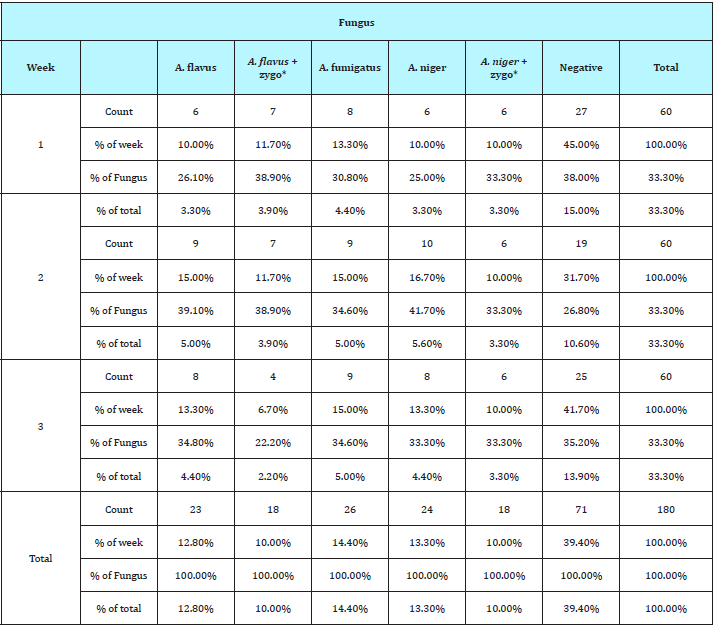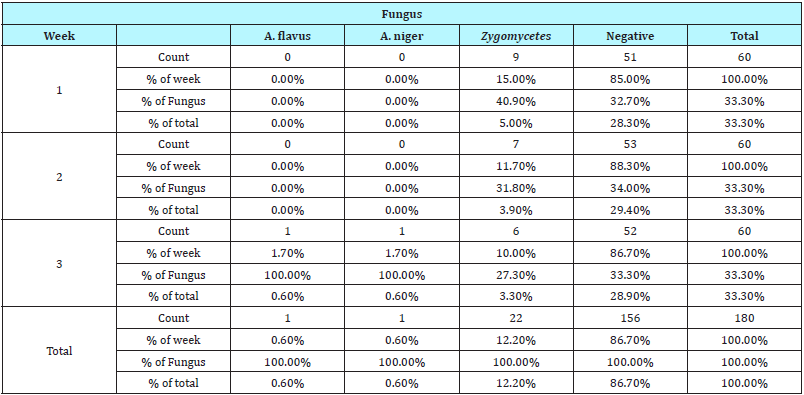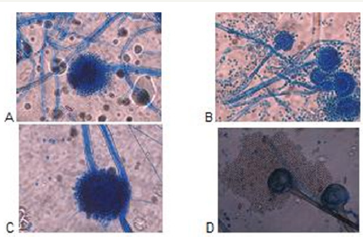- Submissions

Full Text
Approaches in Poultry, Dairy & Veterinary Sciences
Mycological Evaluation and Mycotoxin Contamination of Swine and Poultry Feed-Shelf Life Assessment in Makurdi, Nigeria
Maina NM1, Maina MM2*, Zanna MY2, Lawani MA3 and Vinkings EG1
1Department of Biological Science, Federal University of Agriculture Makurdi, Nigeria
2Department of Veterinary Microbiology, University of Maiduguri, Nigeria
3Department of Veterinary Microbiology, University of Maiduguri, Nigeria
*Corresponding author: Itza Ortiz Mateo Fabian, Department of Veterinary Sciences, Universidad Autonoma de Ciudad Juarez, Av Mexico, (656) 688 1800 ext. Plutarco Elias Calles #1210, Foviste Chamizal, 32315, Cd. Juarez, Chihuahua, 1445
Submission: February 01, 2018;Published: February 23, 2018

ISSN: 2576-9162 Volume3 Issue1
Summary
The species Aspergillus spp. Is the main cause of respiratory mycosis with high mortality and morbidity, reducing the poultry farmer’s profits. The objective of this study was to isolate and identify the presence of the main fungal strains in a commercial farm of replacement pullets. 60 pullets were sampled from the reception in the farm (day one) for three weeks (180 birds) and 15 of those housed in the shed at day eight of age (180 birds). A 1cm portion of lung was seeded on potato dextrose agar. The fungi were identified by morphometry. The data was analyzed by SPSS for Windows. They isolated and identified Aspergillus fumigatus, A. flavus, A. niger and the presence of Zygomycetes spp. (P>0.05). Mortality due to aspergillosis occupied the second place (P<0.01). It is concluded that in addition to aspergillosis zygomycosis is the cause of respiratory problems and mortality in farms.
Keywords: Aspergillosis; Mortality; Zygomycosis; Replacement pullets
Introduction
Aspergillosis is a condition produced by the fungus of the genus Aspergillus, mainly belongs to the storage flora, which is widely distributed in nature; its members are the cause of opportunistic infections that affect any captive or free, domesticated or wild bird [1-3]. Infection with Aspergillus fumigatus is a common disease that causes a respiratory condition known as respiratory mycosis or pulmonary aspergillosis when animals are exposed to high concentrations of airborne conidia that invade the lungs [4,5].
Mycosis occurs clinically in two forms: acute aspergillosis characterized by acute outbreaks in young birds with high morbidity and mortality, no signs are observed, except suffocation occasionally a “whistle” and diarrheas are observed, the first lesions to the necropsy are located in the air sacs and lungs; and subacute or chronic aspergillosis observed in breeders and sometimes in adult flocks or aviaries, is characterized by dyspnea, accelerated and fatigued breathing, progressive weight loss with cachexia and sometimes kerato conjunctivitis [5-7].
Beds, food, incubators, hatchers, and transport equipment with wet surfaces contaminated with the fungus are the main cause of the problem’s spread; poor nutrition, lack of hygiene and stress are predisposing factors; spores can penetrate the egg shell and infect embryos that already sprout with lesions [8].
The aviculturists keep records of the infectious and noninfectious problems of flocks due to the economic impact they represent; However, many times they do not quantify the importance of each one of the farm conditions individually. Hence, the objective of the present study was the sampling of replacement pullets of one and eight days of age to describe the abundant species of fungi that can be isolated and identified by morphometry and the impact on mortality that they represent in the farm.
Materials and Methods
The data was obtained from a commercial farm of replacement pullets of the Bovans White genetic line, housed in a floor, located in the state of Yucatan, Mexico, 20° 57 ‘6.82 “N and 89° 56’ 30.69” W at a height 5m. The climate is of the Aw0 type, the driest of the hot climates, sub-humid climates according to the Koppen classification modified by García [9], with an annual temperature between 21.0 and 33.8 °C [10]. One-day-old pullets were randomly sampled from each batch of incubator on arrival at farm (reception) for a total of 30 pullets per sample. The receptions were two days a week with an average of 52,000 pullets received per week. Samples were taken during three consecutive weeks. At eight days of age, 15 pellets housed in booth were randomly sampled, 12 booths with a population of 12,000 birds per booth, for a total of 360 pullets (180 on day one and 180 on day eight). Pullets were sacrificed by cervical dislocation based on NOM-033-ZOO-1995. A fragment of a 1cm lung was seeded using Petri dishes with potato Dextrose agar, incubated for five days at room temperature and the macroscopic characteristics of the colonies were observed. A sample was taken from the colony and stained with cotton blue for morphometrics identification using the Department of Pathology database at the University of Texas Health Science Center San Antonio, TX.
Data were analyzed using SPSS for Windows using a contingency table for age at sampling and week; and frequencies between causes of mortality, chi square test (P <0.05) [11].
Results and Discussion
The results found during the sampling at day one of age in pullets are presented in Table 1. During the sampling, the presence of Aspergillus flavus (12.8%), A. fumigatus (14.4%), A. niger (13.3) was identified by morphometry. %), and in 18 observations, A. flavus plus zygomycota (10.0%) were isolated and identified in 18 observations. A. niger plus zygomycete (10.0%) (Figure 1), which were isolated. No difference was found (P> 0.05) with respect to the frequency of fungi isolated by sampling. Larone [12] mentions that A. fumigatus is the most commonly isolated species in nature due to its unique ability to grow at temperatures between 20 to 50 °C and rapid growth, followed by A. flavus and A. niger and have returned the main pollutants in places conducive to their growth. The study showed that replacement pullets can get infected with Aspergillus to farm and find in the same bird the presence of two different species of Aspergillus from one day of age. This supports the fact that embryos may be contaminated during incubation due to storage and inadequate disinfection of incubation facilities and equipment [8].
Table 1: Week contingency table for fungus in pullets sampled at day one of age at reception on farm.

*Zygomycetes
No differences between chi-square means (P>0.05)
The results of the sampling at the eighth day of age are observed in Table 2, it can be seen that the presence of zygomycetes (n=22) was the most abundant compared to the presence of A. flavus (n=1) and A. niger (n=1) No difference was found (P>0.05) with respect to the frequency of fungi isolated by sampling. The presence of Zygomycetes spp. in pullets, they are considered more aggressive due to their rapid growth (three days) and tissue invasion (Larone, 1995), because they can grow on the floor at a temperature between 50 to 55 °C, humidity between 60 to 85%.
Table 2: Weekly contingency table for fungus in pullets sampled at day eight of age in the farm.

Figure 1: Fungus isolated and identified by morphometry: Aspergillus flavus (A), Aspergillus fumigatus (B), Aspergillus niger (C), Cygomicete: Rhizomucor spp. (D) on replacement pullets sampled at day one and eight of age.

Sampling at eight days of age showed that the presence of Zygomycetes spp. (12.2%), was greater than the presence of the genus Aspergillus spp. (0.6%), due to the invasion capacity of the first [12]. The appearance of problem by aspergillosis was observed from the fourth day of age in the pullets housed in the farm and persisted until 14 days of age.
The lack of an adequate disinfection or a role of products in an incubator can lead to the presence of fungi in the facilities and transport equipment, putting the pullets at risk, as shown by the results found on day one and during its first 14 days of life where mortality by aspergillosis represented 0.99% of accumulated mortality, if you take into account that the accumulative mortality of the genetic line is 3.0% at 112 days.
Conclusion
The presence of Aspergillus spp. and Zygomycetes spp. was demonstrated in the same bird. The presence of fungi of the genus Zygomycetes in pullets with respiratory problems, are the cause of the infection that should be referred to as zygomycosis, which together with aspergillosis, are causing respiratory problems that increase the mortality of replacement pullets on farms.
References
- Hesseltine CW (1976) Mycotoxins and Other Fungal Related Food Problems. In: Joseph VR (Eds.), American Chemical Society, Washington DC, USA, pp. 1322.
- Davidson WR, Nettles VF, Couvillion CE, Howerth EW (1985) Diseases diagnosed in wild turkeys (meleagris gallopavo) of the southeastern united states. J Wild Dis 21(4): 386-390.
- Lair-Fulleringer S, Guillot J, Desterke C, Seguin D, Warin S, et al. (2003) Differentiation between Isolates of Aspergillus fumigatus from Breeding Turkeys and Their Environment by Genotyping with Microsatellite Markers. J clin microbial: 1798-1800.
- Henrici T (1939) An endotoxin from Aspergillus fumigatus. J Immunol 36(4): 319-338.
- Moreno RC, Valdés MSE, Cervantes ORA (2002) Evaluación de la producción de gliotoxina en 10 cepas de Aspergillus fumigatus obtenidas de aislamientos clínicos. Téc Pucu Mex 40(2): 139-148.
- Richard JL, Thurston JR, Peden WM, Pinello C (1984) Recent studies on aspergillosis in turkey poults. Mycopathologia. 87(1-2): 3-11.
- Peden WM, Rhoades KR (1992) Pathogenicity differences of multiple isolates of Aspergillus fumigatus in turkeys. Avian Dis 36(3): 537-542.
- Kunkle RA, Rimler RB (1996) Pathology of acute aspergillosis in turkeys. Avian Dis. 40(4): 875-886.
- García E (1973) Modificación al sistema de clasificación climática de Köeppen. UNAM, México, pp. 214.
- Itzá MF, García L, Castro F (2006) Consumo de alimento, causa y porcentaje de mortalidad en granjas de postura comercial bajo condiciones climáticas de Yucatán, México.Vet Méx 37(3): 379-390.
- Mendenhall W (1994) Introduction to probability and statistics; In: Introduction to Linear Model and the Design and Analysis of Experiments. In: Mendenhall WR, Beaver J (Eds.), Belmont, California, USA, pp: 244-251.
- Larone DH (1995) Medically Important Fungi - A Guide to Identification (3rd edn). ASM Press, Washington, USA.
© 2018 Itza Ortiz Mateo Fabian. This is an open access article distributed under the terms of the Creative Commons Attribution License , which permits unrestricted use, distribution, and build upon your work non-commercially.
 a Creative Commons Attribution 4.0 International License. Based on a work at www.crimsonpublishers.com.
Best viewed in
a Creative Commons Attribution 4.0 International License. Based on a work at www.crimsonpublishers.com.
Best viewed in 







.jpg)





























 Editorial Board Registrations
Editorial Board Registrations Submit your Article
Submit your Article Refer a Friend
Refer a Friend Advertise With Us
Advertise With Us
.jpg)






.jpg)













.bmp)
.jpg)
.png)
.jpg)














.png)

.png)



.png)






